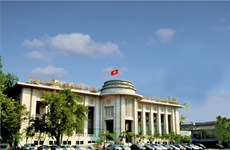Agriculture should aim for 3 percent growth: official
Nguyen Anh Tuan, Director General of the Institute of Policy and Strategy for Agriculture and Rural Development, said that a target growth rate of 2.5-3 percent over the next five years is feasible.
 Nguyen Anh Tuan, Director General of the Institute of Policy and Strategy for Agriculture and Rural Development (Source:Nong thon Ngay nay)
Nguyen Anh Tuan, Director General of the Institute of Policy and Strategy for Agriculture and Rural Development (Source:Nong thon Ngay nay) * For the next five years (2016-2020), Vietnam has set a target growth rate of between 2.5 to 3 percent per year for domestic agricultural production. How did the Government determine this probable growth rate percentage?
The Government set the target of 3-3.5 percent growth rate per annum for the agriculture industry. However, due to the harsh conditions this year, including severe drought and salt water intrusion caused by climate change, agricultural production has been severely affected.
Low prices for many agricultural products, including rubber and coffee - Vietnam’s main products on the world market - have negatively affected national revenue.
For these reasons, a target growth rate of 2.5 to 3 percent over the next five years is realistic.
To achieve that target, the Government will speed up the agriculture restructuring process by applying high tech to agricultural production, while ensuring sustainable development and food safety.
Remember that from 2006 through 2010, our agricultural industry recorded a growth rate of 3.2 to 3.3 percent per annum.
* What should Vietnam do to ensure that the target growth rate is achievable?
There are three things we should do right now:
First, we must adopt workable plans to cope with natural calamities and epidemics.
Second, food safety must be our top priority to win customers’ confidence – both within and outside of Vietnam.
Third, we must look for new markets for our agricultural products. This is a realistic and effective measure to encourage farmers to expand production and increase their productivity.
Looking farther ahead, we should help farmers to produce on a larger scale and to connect with supply chains.
We should also aid farmers to apply high tech to their production methods. And we should encourage farmers to conserve available production resources, such as land and water.
* Farmers living in the central highlands and the Cuu Long (Mekong) Delta have been affected by severe drought and salt water intrusion. Does the Government have plans to adapt to such harsh weather conditions?
We should review our available natural resources - including land, water resources and others - before designing adaptation strategies to cope with climate change. For example, growing wet rice cultivation yields low productivity. So we should consider growing other plants adapted to drought and salty water. We should also look at constructing irrigation systems for purposes such as rice irrigation, aquaculture cultivation, industrial trees, and even to fight forest fires.
As for land use, we should re-evaluate benefits derived from forests and coastal areas - for the purpose of increasing their valuation, while conserving natural resources.-VNA













